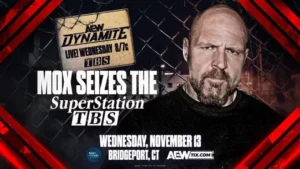In this series, James Staynings takes a deep dive into AEW’s short but impactful history, its present, and its future. In part 1, James discussed how AEW changed the wrestling industry (here). In Part 2, James discussed how AEW’s continued existence benefits wrestlers and fans alike (here).
Part 3 has been divided into two articles. One discusses the differences between in-ring action and storytelling (here). The other excellent in-ring action is compensating for wider issues in AEW creative (here). The final part will discuss AEW’s future. Including discussing the problems that AEW faces and questions Tony Khan will have to address.
The following is a bonus article! Its focus is on dissecting the negative PR AEW receives from critics and the company’s response.
Only Proven True
“To be AEW is to be under constant attack.” Tony Khan, Final Battle media scrum 2023.
I had to question myself after reading this statement. My article evaluating The Elite’s “putrid” 2023 had just been published and I’d received both insults and accusations of being an anti-AEW WWE shill/mark. “Writers like you…”. Comments that said my opinion meant little.
In the grand scheme of things, I don’t disagree. It’s funny in hindsight those folks behind their screens couldn’t see I was wearing a “Hangman” Adam Page t-shirt as I read their views.
I felt then and I still feel now re-reading that article that what I said was fair. I pointed out issues in AEW that still exist in the creative process that I’ve discussed throughout this series. Although afterward, I’ve consciously tried to ensure my language and content are balanced to capture a range of fan perspectives, as well as my own.
I questioned myself and the conclusion I drew from Khan’s statement was double-sided. Yes, AEW has and is under attack by certain parties who profit financially from their takes.
At the same time, AEW was critically in a low period experiencing both constructive and bad-faith criticism. From a PR standpoint, it offered a temporary deflection from both.
A politically defensive move that was right at the time. In the short term, wider trends in discord were spotlighted. Long-term, Khan has been proven right. Various media outlets, from Voices of Wrestling to WhatCulture have published content explaining how and why AEW is being targeted.
Cottage Industry
The term cottage industry applies to the concept of small-scale business, usually that operates within a small location by one person or a small team. The origin of wrestling podcasts and their content goes back to the shoot video market that existed from the early 2000s to the 2010s.
Former and current wrestlers and personalities with the more extreme, outlandish, and populist opinions sold more. They were asked back to record more content and make more money.
It’s evolved into podcasting where from the comfort of their homes, personalities can share their opinions and earn money for this. The ends justify the means. as when criticism is rewarded by financial gain.
The anti-AEW cottage industry, a niche within the niche of wrestling news coverage, focuses on peddling a one-sided narrative that the promotion is incompetent and constantly in a state of decline and failure.
The primary figures in this, your Disco Inferno, Konnan’s (who unironically criticized AEW while working with them to share talent with AAA), Jim Cornette’s, and Eric Bischoff’s have moved from constructive criticism towards outright dismissal.
During the shoot interview era, some personalities criticized WWE’s product, the current wrestlers of the day, as well as TNA and ROH as inadequate alternatives. Unlike these shoot interviews, even those anti-WWE wrestlers who shot at the company rarely threw into the conversation the possibility that WWE could die.
Why WWE Did and Still Gets a Pass
Vince McMahon’s legacy at present is that of a man who has been able to work with everyone. Steering past financial ruin, the government and finding ways to make WWE profitable without the need for the fans during a period of barren creative has aided this perception that the man and WWE are Teflon.
Even critics like Cornette who hated Vince’s wrestling philosophy had to give respect.
Given WWE has only gone from strength to strength with Vince gone also and the general perception of WWE in a Renaissance, it’s easy to make historical comparisons. AEW therefore is the WCW of today.
WWE’s PR machine has insulated the company at present. When breaking down “The Paul Levesque Era”, Nick Khan and Chris Legentil, perhaps more so than Triple H are responsible for the promotion’s growth. Especially, in terms of PR and promoting news media stories that tell the narrative WWE wants to be presented.
WWE benefits massively from history and repeated triumphs over adversity. Vince’s ability also to politically manipulate and use language to change the way fans even speak and think about wrestling is another aspect of his legacy.
Consequently, it impacts how some see AEW. Whether intended or not, WWE’s position impacts this cottage industry. The company is hot and giving many WWE fans what they want.
WWE has changed for the better and for some fans that’s all they wanted. Paraphrasing Brian Zane of Wrestling With Wregret, did some fans want an alternative wrestling company or did they just want WWE to be good?
Dangerous and Corrosive Narratives
As humans, we are more attuned to focus on the negatives. It’s what makes this cottage industry so powerful. The frequency of content has led to the issue that long-term narratives, even those that are false, have become true.
Whether this is the lie that AEW is too busy pursuing Dave Meltzer’s five-star ratings or Meltzer is an AEW defender, a little research would show otherwise.
Videos exist showing The Elite and Will Ospreay all saying they do not put value in Meltzer’s subjective system. Likewise, listening to a Meltzer podcast would reveal how critical the man is of AEW’s current product.
This impacts fans across the divide. It gives ammunition to anti-AEW fans. I know myself that some are happy, without invitation, to tell you why AEW sucks. It’s draining. Even staying out of the discord, blocking accounts, or avoiding subreddits, the barrage is still constant.
Repeated enough times, some AEW fans who do not do research believe these sentiments. Out of four other folks in my friendship group who are wrestling fans, three out of five brought up the five-star ratings-chasing narrative at some point in our discussions.
Possibly the most pernicious and widespread criticism of AEW has snowballed into an avalanche of bad faith. AEW doesn’t tell stories. When someone tells me this, I often imagine they searched through Dynamite or Collision with the enthusiasm and effort of John Travolta in that viral Pulp Fiction meme.
Although, as stated earlier in this series, at its core, some elements of bad faith, either by accident or its in origin, do hit on some home truths.
It’s Not All Bad Faith
One thing must be clear. Not all criticism of AEW is bad faith. Online AEW fans just as easily as anti-AEW fans will dish out sweeping generalizations, statements, and name-calling.
It’s easy to call someone a “mark”, “shill” or some other term that reduces a person and their opinion/perspective to somehow a different kind of human being. Fans and AEW itself have sometimes fallen into the binary of all-or-nothing discord. You’re with us or against us.
The issue with the cottage industry discord and then defense against it often reduces complex issues to oversimplifications. Sometimes blocking out or ignoring valid points of view.
Stories are being told in AEW. Sometimes AEW suffers through polarising extremes. The issues are often related to execution and long-term thinking. Sometimes things are too busy.
Wrongly accused as a “shill”, Dave Meltzer has pointed out that the promotion often tries to tell too many stories. It’s hard to remember all of them, especially when AEW can be at times too subtle and too implicit.
Sometimes story beats and elements are missing, forgotten, or developed sporadically. Some things are stretched out for too long while others are rushed.
Other times stories can rely on tropes that become repetitive, and events play out mechanically. There are lots of contrasts and contradictions. The overall issues come down to a lack of long-term planning and managing quality control.
It doesn’t mean all AEW storylines are inherently bad, but just scattergun. Yet scattergun pellets still can hit the bullseye and the target.
But what happens instead for various reasons is the reality gets streamlined into digestible stories supporting one side or the other. Likewise, comparisons between the similarities in successes and mistakes of AEW and WWE are ignored due to this tribalism.
Role Reversal
Comparisons of AEW to WCW’s last legs or TNA are false pearls. I’ve watched enough of old WCW to what AEW produces in the ring and even flawed in the storyline at least resembles wrestling as we know it. I lived through the lol TNA era.
I watched desperately and increasingly becoming depressed as the strong wrestling product was dismantled. AEW creatively is not the same. There’s not enough Vince Russo-inspired ballyhoo to make that comparison stick.
When discussing AEW’s relationship with WWE, AEW promised to do the opposite of what WWE was doing. If anything, AEW’s flexible logic and lapses of continuity are more akin to WWE than WCW or TNA tropes.
AEW’s books in some ways like the later stages of Triple H’s Black and Gold Era NXT. It’s more than just because wrestling is seen as superior.
Sometimes match graphics sell matches promising excellent in-ring action. Increasingly, some matches have become excessively long, fulfilling the idea longer is better. Yet this forgets quality can beat quantity.
The stars NXT focused on were indy darlings and great wrestlers with limited characterization or storylines beyond a certain set of tropes. Like the challenger picks up a belt. Challenger stands on the ramp.
Beat down in the car park. A similar repetition that I’ve discussed with a different set of tropes AEW has often relied on. In both cases, what was sometimes missing in the storyline was the heart.
Selective amnesia around WWE being good once again has helped some ignore comparisons. Tribalism and its mindset of polarised differences can’t comprehend that these two millionaire bosses could be similar. They must be complete foils of each other.
AEW’s Response to Being Attacked
At times, rather than focusing on improving the company and creativity from the inside, AEW has dedicated segments and storylines to purposefully address critics. Inadvertently, the company has not helped itself and at times legitimized criticism.
Adam Copeland cut a rah-rah speech on April 3rd’s Dynamite, responding to CM Punk’s MMA Hour criticism. Ironically, it validated CM Punk’s criticism that AEW cares more about catering to its fanbase and good matches than growing its business. It made the company seem defensive and hurt by criticism.
The implied bleeding only attracted more sharks and suggested the company was in trouble.
Wrestlininc’s Ross Berman described how described the tone as “oddly apocalyptic”, describing the speech as being cult-leader-like:
“It was the opposite of reassuring — it was sweaty and desperate. It felt like Tony Khan speaking through Copeland, bragging about recent free agency signings like Kazuchika Okada and Will Ospreay”, Ross Berman, WrestlingInc.
At times, AEW, whether through Tony Khan’s speeches tweets, or comments from Dax Harwood or Will Ospreay have furthered polarisation by implying a notion that AEW saved wrestling.
As a PR narrative, the implication that fans should be grateful for AEW doesn’t compensate for poor form. It also contradicts the implied promise that AEW would hold itself accountable to fans.
Other writers, like Michel Sidgwick, echoed this sentiment.
“This idea of AEW as the purely good spiritual home of pro wrestling that must be protected at all costs – in addition to throttling the ticket-selling philosophy of personal animosity – is arrogant. And this mentality, off-putting especially when AEW as a wider product is lacking, has crept in elsewhere to become the defining narrative.” Michael Sidgwick, Whatculture.
Move On
At present, AEW is still defining itself as oppositional to WWE. This has been seen in the Corporate Elite storyline, which despite initial promise faltered in part ironically due to McMahonism’s flexible logic.
No stakes for Anarchy in the Arena and an artificial power struggle. Although the battle for AEW’s heart and soul from AEW vs. former WWE guys to AEW trying to save the company from itself (in the form of The Elite), the same mistakes have been made.
AEW by focusing on itself and its three letters as the selling point of the product is short-sighted and only gives critics more fuel.
Ultimately, as in politics, engaging with bad faith only leads to giving it relevance. It’s the false balance fallacy. By responding and giving the other recognition, a chance to respond, you present both viewpoints as equal and valid.
What made AEW elite was doing various aspects of pro wrestling well. Not just the wrestling. Not trying to prove that AEW is a valid alternative. Rather than tell fans already buying into AEW this is awesome, the company needs to focus on showing it again.
Things Are Always Subject to Change
Right now, AEW should focus on whose house? Their house. Stop focusing during this current media war about throwing shots at the fortified castle that is WWE. Or demolishing the small cottages surrounding it. Focus on themselves because as time has proven, things can change quickly.
Realistically, Khan isn’t going to stay quiet due to the handbook he is playing from as a “challenger brand”. However, as I’ll discuss in the final part of this series, Khan needs to look beyond the wrestling product to evolve AEW.
The real war isn’t about wrestling, it’s about perception. And right now, AEW’s approach in the short term is not going to change cultural divisions.
More From LWOS Pro Wrestling
Header photo – AEW – Stay tuned to the Last Word on Pro Wrestling for more on this and other stories from around the world of wrestling, as they develop. You can always count on LWOPW to be on top of the major news in the wrestling world. As well as to provide you with analysis, previews, videos, interviews, and editorials on the wrestling world. You can catch AEW Dynamite on Wednesday nights at 8 PM ET on TBS. AEW Rampage airs on TNT at 10 PM EST every Friday night. AEW Collision airs Saturday at 8pm Eastern on TNT. More AEW content available on their YouTube.






